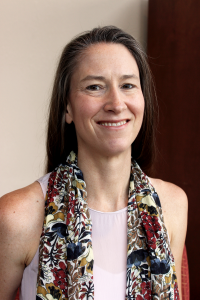 |
Alison Buchan, Microbiology
Students will participate in research examining viruses that infect members of the ecologically important Roseobacter clade of heterotrophic marine bacteria and the influences that viral infection have on host activities and the fate of microbial carbon and nutrients released by viral activity. Using our recently established and environmentally relevant phage-host model systems, students will participate in metabolomics studies to examine the effect of virus infection on host metabolism. Students will also participate in metabolomics studies of microbial isolates and mixed populations consuming cellular components released by phage-mediated lysis of roseobacters. |
 |
Jennifer DeBruyn, Biosystems Engineering and Soil Science
Students will research microbial ecology of soil and terrestrial systems, with intent to understand carbon cycling dynamics. Focus areas will include microbial communities involved in crop ecosystems and decomposition (composting) of cadavers. Students will use molecular techniques and chemistry to further our understanding of soil community structures, carbon cycling and taphonomy. |
 |
Carolyn Ibberson, Microbiology
Our lab studies microbe-microbe interactions in chronic infection sites, particularly chronic wounds and cystic fibrosis. My lab characterizes the physiological, molecular, spatial, and ecological mechanisms that determine how microbes interact in complex polymicrobial communities with an interdisciplinary approach that integrates, genetic, computational, microscopy, and omics-based approaches with classic microbiological techniques. Our ultimate goal is to define the “rules” of how microbes interact in structured host communities and the impacts of these interactions on community function and host health. |
 |
Elizabeth Fozo, Microbiology
Students will conduct research in molecular microbiology and microbial physiology examining the mechanisms used by bacteria to acclimate to changing environments. Specifically, students will examine how growth in host fluids can lead to alterations in cell membrane and wall content of Enterococcus faecalis, a common hospital-acquired infection, and contribute to antibiotic resistance. Students may also contribute to understanding how small regulatory RNAs and small proteins produced by pathogenic Escherichia coli O157:H7 can induce antibiotic tolerance. For both projects, students will create or utilize strains deleted for key genes and examine how loss of those genes contributes to antibiotic sensitivity and overall growth effects. |
 |
Heidi Goodrich-Blair, Microbiology
Students will use bacterial genetics, genomics, microscopy, and molecular and biochemical approaches to investigate the symbiotic interactions of the bacterium Xenorhabdus with its animal hosts. Xenorhabdus is a mutualist of Steinernema nematodes and a pathogen of a wide range of insects, and experimentation on this system will give students experiences in a broad range of skills in bacteriology, nematology, and entomology. Students will explore research questions that address evolutionary, ecological, and physiological principles underlying symbiotic associations.
|
 |
Andrew Monteith, Microbiology
The mission of the Monteith laboratory is to explore the delicate balance that exists between metabolic and inflammatory processes, and how perturbations in this equilibrium promote disease. Bacterial pathogens like Staphylococcus aureus have evolved an arsenal of virulence strategies to subvert the immune response. We seek to understand how neutrophils detect disruptions elicited by bacterial pathogens and shape their inflammatory processes like neutrophil extracellular trap (NET) release to suit the constraints of the environment. In addition, comorbidities like diabetes, obesity, and autoimmune disease associate with massive shifts in metabolic homeostasis coinciding with an increased risk for bacterial infection. We seek to decipher how these changes to metabolism affect myelopoiesis and downstream neutrophil effector function in dysregulating inflammation during infection.
|
 |
Qiang He, Civil & Environmental Engineering
Students will conduct research on the microbial ecology of biofilms in drinking water distribution systems. Biofilms pose public health risks by impairing water quality integrity and serving as a reservoir of harmful microorganisms. The focus of this study is the microbial functional characteristics underlying the development and persistence of biofilms in disinfected water. Students will employ molecular techniques to identify microbial functional groups predominant and persistent in drinking water distribution systems and determine the biochemical functional features enable biofilm development, which could be used to develop more effective water quality control strategies. |
 |
Zachary Burcham, Microbiology
Increasing our understanding of the microbial interactions has tremendous potential to improve agricultural, environmental, and human health. Our lab focuses on host and environmental microbiomes, microbial community cooperation and competition, and modulation of community function. Current lab research spans diverse biological scales, including the microbial roles in organic waste cycling, forensic microbiology, and human health. We utilize a combination of environmental sampling, laboratory models, multi-omics, and bioinformatic tools to explore the relationship between microbial diversity, microbial interactions, and ecological outcomes in free-living and host-associated systems.
|
 |
Tatiana Vishnivetskaya, Microbiology
The polar regions are geologically and ecologically diverse and occupy over 20% of the Earth’s land surface, including 85% of Alaska, 50-55% of Canada and Russia, 20% of China, and most of Antarctica, and Greenland. Sediments, soils, or rocks that remain at or below 0ºC at least 2 consecutive years are defined as permafrost. The permafrost is situated below the upper thin soil layer that experiences seasonal freezing and thawing and is called the active layer. Due to global temperature increase the active layer became thicker and upper permafrost horizons undergo thawing and degradation. These environmental changes (increases in air and soil temperatures) lead to environment transformation (waterlogging, oxygen deprivation, etc.) followed by reshaping of the microbial community. Current research is focused on uncovering microbial biodiversity in perennially frozen and active layer soils of the Arctic, including northern regions of Canada, Russia and Svalbard. Based on published data the temperature in the high Arctic is expected to increase. In this case the permafrost will become a major source of ancient microorganisms which could be involved in modern biogeochemical cycles and greenhouse gas production. Functional analysis of the available permafrost/active layer metagenomes will determine the metabolic potential of the microbial community. Specifically, metabolic pathways for autotrophy, production or consumption of CO2, N2O and CH4, as well as SOC-degrading enzymes, will be assayed within the genomic material. The use of specific microbiological media and amended microcosms will be based on this information. Isolation of bacterial strains will provide proof and show what kind of bacteria could easily get involved in biogeochemical processes and probably play a key role in formation of new landscapes or new types of soils. Metagenomics will link phylogenetic and functional information about the biota of low temperature environments dominated by unculturable organisms while microcosms approach will provide the advantage of allowing us to investigate under controlled conditions the effects of thawing processes on natural microbial communities.
|
 |
Jill Mikucki, Microbiology
Students will study the microbial ecology of icy Antarctic ecosystems with a focus on subglacial lake and sedimentary environments. Students will employ microscopy, molecular and culture techniques to examine the relationship between microbial diversity, the subice environment and the cycling of key metabolic substrates to understand how microorganisms survive and grow under extreme cold and dark conditions. Students will work with Antarctic samples to isolate and characterize ecologically relevant microorganisms and evaluate how isolates respond to changing environmental parameters. Students will also help develop and test appropriate ‘clean access’ techniques for sampling pristine frozen environments for application to future subglacial drilling projects. |
 |
Todd Reynolds, Microbiology
Students will conduct research studying how fungi in the genus Candida interact with one another and their normal environment. Candida species are part of the normal flora of humans (commensals), but are also the most common opportunist fungal pathogen pathogen of people that are immunocompromised. We will focus on how Candida yeast cells participate in intercellular communication with one another or the host via quorum sensing factors, cell wall interactions, and response to nutrient in their immediate environment. |
 |
Chunlei Su, Microbiology
Students will conduct research in the area of population genetics and evolution of virulence in the protozoan parasite Toxoplasma gondii. The goals are to understand the origin, the global transmission patterns, the mechanisms of clonal expansion of a few predominant lineages of T. gondii. Students will employ molecular techniques to identify and genotype Toxoplasma strains collected from domestic animals, wildlife and humans. Students will also help develop a global geographical information database to integrate Toxoplasma population diversity data collected in our laboratory. |
 |
David Talmy, Microbiology
Bacteria are present in seawater throughout the world’s oceans, influencing nutrient regeneration, and ultimately the Earth system. Despite decades of field cruise collection of data on the abundance of different bacteria groups, we still have limited understanding of factors controlling their global distribution and activity. The undergraduate student in this project will synthesize data from existing literature and compilations, to begin to build a view of global bacteria distribution and activity. The student will use the data to help interpret and guide global scale microbial ecosystem model simulations. |
 |
Rebecca Trout-Fryxell, Entomology and Plant Pathology
Students working in the Medical and Veterinary Entomology laboratory will have the opportunity to identify, describe, characterize, and compare microbial communities (and potential pathogens) within arthropod vectors such as mosquitoes, ticks, and flies. |
 |
Steven W. Wilhelm, Microbiology
Students will have opportunities to conduct research in several areas including how viruses shape microbial communities, the interactions between viruses and prokaryotes influences biogeochemical cycles, and investigations into the root causes of toxic algal blooms. Students will employ molecular techniques. Students will help develop new approaches so that relationships can be extended to new model organisms from freshwater and marine systems. State-of-the-art molecular and bioinformatics tools are available to provide training tractable to any area of the biological and environmental sciences. |
 |
Erik R. Zinser, Microbiology
Students will conduct research in the general area of microbial ecology of aquatic systems, with a focus on how biotic and abiotic factors impinge on the growth and physiology of the globally-abundant marine cyanobacterium, Prochlorococcus. Students will use classical as well as modern molecular approaches to characterize the genetic underpinnings of the responses of Prochlorococcus to variations in environmental parameters, such as temperature and light, and will also characterize their interactions with other members of the marine microbial community, including heterotrophic bacteria and other primary producers, such as Synechococcus. For the latter studies, metabolomics will also be employed to investigate mechanisms of nutrient cross-feeding between members of different trophic groups. |